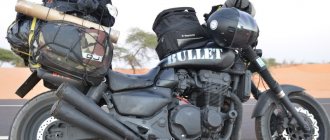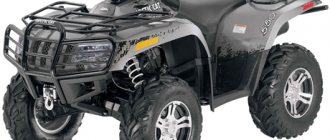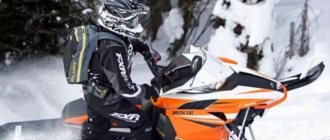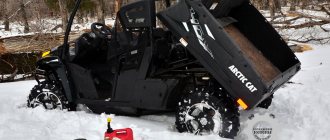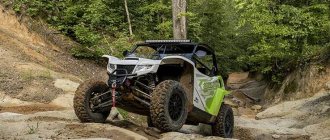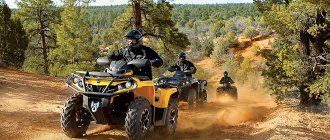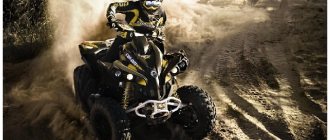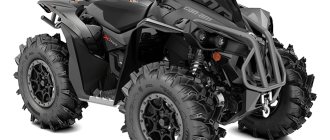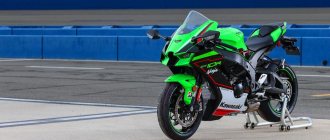07.10.2011
Power steering allows the ATV to be more maneuverable.
Held in Utah, near Moab, the ATV show at Manti-La Sal State Park served as a worldwide showcase for the new 2010 Arctic Cat . We were able to see six new models with power steering. In particular, we were presented with three 550 s models and three 700 s models. Although some experts believe that power steering is no longer an innovation, we cannot agree with this opinion. Among other things, what we saw was a completely new concept for the Arctic Cat ATV and could not but arouse a feeling of admiration.
The addition of power steering for Arctic Cat ATVs demonstrates the company's continued commitment to always being at the forefront of the industry, as well as a desire to improve and improve its products. And, of course, to provide ATV drivers with a car that meets the most stringent requirements. After spending some time behind the wheel of this miracle, we can confidently say that when it comes to additional features and comfort, Arctic Cat has outdone itself.
We've driven a number of so-called "pre-pro" cars at this show, but we'd like to take a closer look at the 700 s, which was originally a 700 H1 EFI 4x4 with the addition of power steering and other minor changes.
Electronic power steering
Inside the chassis is a new aluminum electronic power steering system housed in an aluminum housing. This unique product, which Arctic Cat created in collaboration with Globe Motors, took almost three years to develop. The result was a part that outperformed all its competitors in the industry. As one of the largest power steering units in the industry, the 6.35 kg module required minor frame tube modifications to assemble. Arctic Cat engineers had to tighten the frame tube slightly while maintaining structural strength.
Speaking about his brainchild, the company's production manager Mark Esala said that the variable power steering will change depending on the driver's style and driving method. He called this design “nonlinear,” meaning its inputs are not equal to its outputs. The so-called brain responsible for the flawless operation of the system is called the Electronic Control Unit (ECU). Its job is to correctly read the tire resistance input forces and vehicle speed and then determine the required output. It's pre-programmed to maintain light steering effort while maintaining enough traction response to allow the driver to feel his wheels as they make contact with the road surface. In simpler terms, the system will help you if necessary, but will not deprive you of that unforgettable feeling of the ground under the wheels, which is why you got on the ATV. Arctic Cat proudly calls its invention a connection between the rider and the ATV, and I'm willing to bet that competitive electric power steering can't do that. “At high speed or torque, the system responds much faster, and at high speed and high power it will not shut down like many other competitive models,” Esala explained.
POWER POWER STEERING INPUT 1. RPM 2. MPH 3. Steering Wheel Input 4. Wheel Input POWER POWER STEERING OUTPUT 1. Faster response than competitors (according to Arctic Cat) 2. 36 ft.-lb. pounds (three times higher than competitors)
The system starts working as soon as the driver turns the key in the ignition or at idle. The company added this function to simplify the movement of the machine manually or within the garage. Along with the convenience of easier maneuvering, electronic power steering will also allow the driver to better maintain their own power when driving the ATV in 4x4 lock mode, on difficult sections of the trail, in the presence of mud, rocks and logs, and with a fully loaded trunk. . If the electronic power steering is turned off, control will automatically switch to traditional manual steering, like in all-terrain vehicles.
Electronic power steering has been tested all over the country and at different times of the year. From winter in Minnesota to summer in Glams and the Sahara deserts. Since we tested machines that had not yet gone on general sale, we can safely say that we were able to participate in the testing and development of these products. We've ridden more than twelve different models of ATVs and all but one have shown excellent results from the electronic power steering. But one copy still failed, as its rear shock-absorbing suspension broke due to a defect in the seams.
Arctic Cat engineers have made another change to the electric power steering. The wheel toe angle was shifted 1/8-inch on each side, which, according to the same Esal, allowed the car and the electronic power steering system to be more freely controlled.
1. Necessary documents for registration. 2. Necessary documents for operation (certificate, UTM, TO, etc.) 3. Quadra on the roads 4. OSAGO Question 1. First, I will consider registration if all documents are available by the legal owner of the vehicle. When registering an ATV, the following documents should be sufficient: PSM (passport for a self-propelled vehicle), DCP (purchase agreement), Transfer and Acceptance Certificate (if specified in the DCP), Appendices (if specified in the DCP, such as, for example, warranty obligations or something else), MTPL policy. Of the optional ones (it is illegal to require them, Decree of the Government of the Russian Federation of August 12, 1994 N 938 “On state registration of motor vehicles and other types of self-propelled equipment on the territory of the Russian Federation”), they may ask for a Certificate and a copy of the customs declaration. Note: if an ATV (snowmobile) was imported before September 2001, the PSM was not issued by customs in order to register it with the State Tax Service d.b. PrEP and AP are enough, and PSM should be issued there too. Here it is better to have a copy of the customs declaration and the Certificate and, in general, as many documents as possible. But the issue may have to be resolved through court. I will leave the question of whether to register the quadr or not for everyone to consider. On my own behalf, I can only advise that if you still decide to drive an unregistered quad, it is better to register and remove it from the register. And it’s easier later when selling, and if you lose the documents, then it’s easier to restore them.
Question 2 When operating an ATV, you must have documents confirming your rights to the ATV (registration certificate, power of attorney for the right to operate), a tractor driver’s license, and compulsory motor liability insurance. A technical inspection is only required when meeting with GTS employees; traffic police officers cannot punish you for lack of registration or a GTO coupon. This is what is required by law. Also, from what the law does not require, I would also advise wearing a HELMET!!!, installing mirrors (when driving on the roads) and wearing protection in addition to the helmet, but this is a personal matter for everyone, like turn signals, road tires, etc. d. Let me remind you that traffic rules do not require a helmet, mirrors or turn signals. In this case, the turn must be shown with your hands (traffic rules).
Question 3 Contrary to popular belief, operating an ATV on roads is ALLOWED. It is only prohibited to drive ATVs on highways and under certain signs, such as, for example, (read traffic rules). Those. There is no article in the Code of Administrative Offenses under which you can be punished simply for driving a quad on the road and you are not breaking the law by driving like that. It is allowed to drive quads on roads and in primary sources, in traffic regulations and in a document such as “Basic provisions for the admission of vehicles to operation and the responsibilities of officials to ensure road safety.” The FAS DECISION (Federal Arbitration Court) of the WEST SIBERIAN DISTRICT dated September 20, 2004 N F04-6774/2004 (A75-4786-15) removes all doubts.
Regarding drinking and driving. Driving while intoxicated is punishable by deprivation of a special right, the right to drive vehicles. Those. in addition to the UTM, they will also be deprived of the automobile driving license.
Question 4 You should always have compulsory motor liability insurance
Go
We've ridden a lot of Arctic Cat ATVs over the years to find that they provide drivers with a comfortable, enjoyable ride, but can sometimes make them sweat. However, the new 700 s, along with the 500 s, give the driver a new experience from the second he turns on the engine. These models not only have proven suspension, ground clearance and reliability, for which we love the cars of this company, but also an electronic power steering system that allows you to control the ATV much better and enjoy riding it.
Improved steering will reduce driver fatigue and give the driver greater control, allowing him to focus on the ride rather than the side issues that arise along the way. We really like this new system and wish the engineers would add it to the Thundercat 1000 and Mud Pro all-terrain vehicles . All that said, we'd really like to compare the 700 S or LTD with other 700s in the same class equipped with electronically controlled power steering to make sure they're good quality. Only in this case will we be able to name a real winner among ATVs.
Description of 700 S class models
The main three of the 700 s series include the base models 700 S, 700 S LTD and TRV 700 S GT. Available in olive green, the 700 s retails for around $9. 249. For an additional $900, the LTD 700 gets a rich blue paint job that is without a doubt the crown jewel of Arctic Cat's arsenal. The Arctic Cat TRV 700 S GT, a two-seat ATV with a metallic gray finish, can be purchased for an almost nominal fee of $9,949. Both the LTD and GT models are equipped with 12-inch automotive-grade aluminum wheels with black inlays, while the 700 s series models just have standard 12-inch wheels.
All machines have a single-cylinder, four-stroke H1 engine with a displacement of 695 cubic centimeters, developed by Arctic Cat. The abbreviation H1 indicates that the engine has a hemispherical shape, which company representatives describe as something that gives their brainchild more efficiency. During our trip, we were very happy to learn that we would be using an electronic fuel injection system, which gives a smooth start and improves the machine's performance in high terrain. The 700 ATV successfully passed all tests and gave us the opportunity to enjoy increased sensitivity to throttle opening, which, unfortunately, cannot be said about its brother 500 model. The easy-to-operate Duramatic automatic transmission, using a continuously variable transmission and belt control, made our ride easy. All you had to do was press the gas pedal and go. The most noteworthy feature of a continuously variable transmission is its improved engine braking. Even on slippery surfaces, we felt the car slow down when we pressed the brakes. This is especially important for those who use their ATVs to haul heavy loads on rocky, rough roads with steep inclines.
Arctic Cat ATVs always perform great on rocky and rough trails. And the powerful suspension of the 700 models and good 11-inch ground clearance play a huge role in this. We've tested Arctic Cat ATVs on sandy roads, among rocks, and in deep swamps, but we've had the greatest fun on snowy trails, where buried obstacles can end your journey in a split second. The all-forgiving suspension and power steering controls made it possible to get real pleasure from riding an ATV. Naturally, the car lost a little control on a two-lane snowy road, but it still felt like a fish in water. It was also nice to feel the additional torque and power of the engine of the 700 model. Sometimes there was a desire to test a model that does not have power steering 700 EFI 4x4 in order to compare it with the 700 series in difficult snowy areas. We can only believe that the power steering saved us from the possibility of overwork.
The 700 S LTD comes with several additional features to match its excellent performance. This includes a factory-installed winch, dual digital/analog odometer/speedometer, and durable steel front and rear bumpers. We especially liked the combined instrument panel, which allows you to watch the needle move up the speedometer scale with the slightest press of the brake. Other experts involved in the tests preferred the digital speedometer. As they say - to each his own!
Arctic Cat ATVs feature hydraulic disc brakes, a two-inch trailer hitch, cargo storage, durable plastics to reduce wear, and a cleverly designed SpeedRack system and a variety of accessories. All these features result in greater convenience and comfort for the driver. However, in our opinion, the braking system is not designed in the best way. The brake response is quite good, but we still prefer separate brake levers. But as they say, there is no arguing about tastes.
Our impression
Arctic Cat has always created products for strong, real men (workers, farmers, hunters) and for those who prefer serious powerful toys, such as the Thundercat and Mud Pro. Both of these machines led us to believe that Arctic Cat isn't afraid to experiment with the design and power of its products. With the addition of power steering, the company managed to create the most comfortable all-terrain vehicle to date. However, we would still really like to compare the new 700 S and 550 S with other all-terrain vehicles from competing companies before we can make a final decision.
The time spent testing the new model flew by unnoticed and this is a very good sign. We were pleased with the power steering and the new product from Arctic Cat in general, but testing the machines on difficult, polluted and forest trails was not enough to get the full picture. Despite the constant desire to spend even more hours behind the wheel of these all-terrain wonders, the newest product from Arctic Cat truly is a great machine. The addition of power steering took an all-terrain vehicle known for its reliability, strength and power to an even higher level of automotive performance and gave drivers added comfort, control and endless enjoyment.
Description of design
ATVs from the Grizzly 700 series are considered one of the largest and most powerful utility ATVs. The power unit for the 2015 model is a single-cylinder four-stroke engine with 4 valves and one camshaft with a volume of 686 cm3, developing a power of 47 hp. But the 2021 models get a new, more powerful 708cc DOHC engine that produces 55 hp. In this regard, the total weight of the ATV has also increased - from 274 to 314 in an unloaded state (i.e. without passengers, fuel and technical fluids).
All other characteristics are common to all Yamaha Grizzly 700 series ATVs:
- The front and rear suspensions are independent, with double wishbones and five-position adjustment.
- The drive system has three modes: 2WD, 4WD and 4WD with forced differential lock.
- Yamaha Ultramatic® automatic transmission with V-belt drive and engine braking;
- Ackermann electric power steering;
- Dimensions 2065x1180x1240 mm, ground clearance 275 mm and wheelbase 1250 mm.
- Maximum load on the trunk is 45 kg at the front and 85 kg at the rear;
- Maximum hook pull is up to 550 kg.
